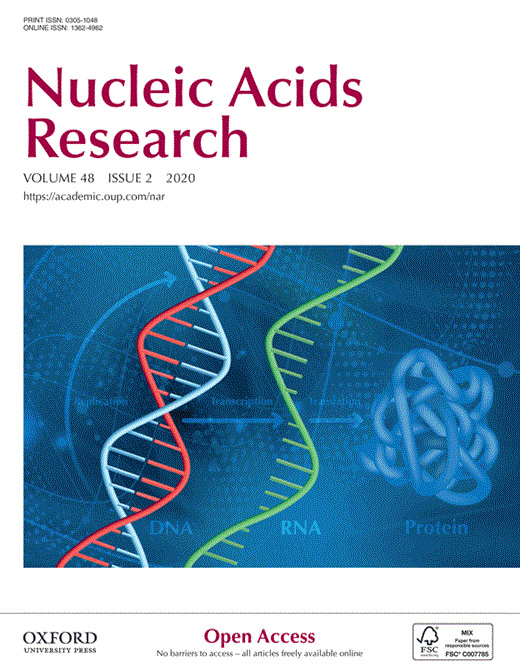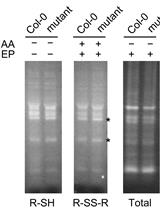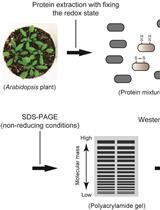- EN - English
- CN - 中文
Novel Protein-oligonucleotide Conjugation Method Involving a High-affinity Capture HaloTag
一种高亲和力捕获卤代烷脱氢酶标记的蛋白质寡核苷酸偶联新方法
发布: 2020年09月20日第10卷第18期 DOI: 10.21769/BioProtoc.3759 浏览次数: 5496
评审: Alessandro DidonnaDiego Acosta-AlvearMaria Dermit
Abstract
Highly sensitive quantitative protein profiling can play a key role in the early diagnosis of diseases, such as autoimmune diseases and cancer. We developed a modified protein-oligonucleotide conjugation method termed HaloTag-mediated barcoding, for quantifying protein molecules at a higher sensitivity than conventional protein quantification methods. This novel and efficient conjugation method can be used to prepare HaloTag-barcoded proteins using a click chemistry-based labeling technique. Here, we describe the preparation of protein-DNA complexes and detection of protein-protein interactions which can be used in a HaloTag protein barcode assay to detect an antibody. The protocol includes procedures for preparing the ligand-oligonucleotide complex, plasmid DNA preparation for protein expression, and preparation of the protein-oligonucleotide complex. The described click reaction-based protocols simplify the conventional amine-ester reaction methods which require additional steps for chromatography purification.
Keywords: Protein barcoding (蛋白质条形码)Background
Protein molecules can be quantified by conventional experimental approaches such as enzyme-linked immunosorbent assay, western blotting, and mass spectrometry. These conventional quantitative protein profiling techniques involve the use of calibration curves for relative measure, without considering the high sensitivity of DNA amplification, that limits the detection of the absolute amount of proteins itself. Chemical proteomics have made possible multiplex assays in a relative quantification manner, such as tandem mass tag labelling methods coupled with mass spectrometry (Thompson et al., 2003). Protein barcoding methods coupled with next-generation sequencing have emerged to identify target protein molecules; these methods include CITE-seq, Ab-seq, and LIBRA-seq for detecting antibody-antigen interactions (Shahi et al., 2017; Stoeckius et al., 2017, Setliff et al., 2019). A high-affinity capture tag, known as the HaloTag, mediated conjugation method was developed with double stranded DNA through amide-bond coupled with high performance liquid chromatography for complex purification (Gu et al., 2014). Here we describe a protocol for a novel protein–oligonucleotide conjugation method involving the HaloTag. This method is advantageous compared to other conjugation methods because it is easy to accurately determine the number of fused protein molecules, as HaloTag-labeled proteins irreversibly bind to the small chemical ligand chloroalkane, which connects to the DNA oligonucleotide barcode in a 1:1 ratio (Yazaki et al., 2020). Additionally, click chemistry-based HaloTag barcode conjugation requires less labor and time by eliminating the need for chromatography purification compared to other conjugation methods where the number and the position of tagging DNA on proteins varies (Gu et al., 2014, Stoeckius et al., 2017, Setliff et al., 2019). This method can be adapted for additional applications, including the identification of antibody-antigen interactions for clinical diagnosis. This technology can also be adapted for single B-cell receptor sequencing to capture antigen-specific cells.
Materials and Reagents
- Strips of 8 low profile tubes (0.2 ml) with flat caps (Thermo Fisher Scientific, catalog number: AB-0776 ), store at RT
- 96-deepwell plate (Mettler Toledo, catalog number: LR-P2-96P )
- Pure Speed PS Tips 1000/20 μl IMAC 12-pk PT-10-N20 Ni-IMAC resin, 12 × 1,000-μl tips (Mettler Toledo, catalog number: PT-10-N20 , material number: 17012572), store at 4 °C
- 5 ml conical tubes (Thermo Fisher Scientific, catalog number: Corning 352063 , store at RT)
- Amicon Ultra-2 Centrifugal Filter Unit (10k column; Millipore-Sigma, catalog number: UFC201024 ), store at RT
- 0.6 ml SnapLock Microtube Non-Sterile MaxyClearMaxymum Recovery (Axygen, catalog number: MCT-060-V )
- DH5a-T1-R competent cells (Thermo Fisher Scientific, catalog number: 12297016 ), store at
-80 °C - LeftRight (LR) clonase enzyme mix (Thermo Fisher Scientific, catalog number: 11791019 ), store at -80 °C
- DMSO (Sigma-Aldrich, catalog number: D8418-50ML ), store at -20 °C
- Cycloalkyne-5’-modified 100-bp DNA oligonucleotides (Table 1, Eurofins, Luxembourg, custom made ), store at -20 °C
- 1 μg/μl HaloTag-Proein G (Kazusa DNA Research Institute, Chiba, Japan, ProteinG-His, store at -80 °C)
- Plasmid template DNA for HaloTag fusion protein ( custom made , see Procedure A and B), store at -20 °C
- Plusgrow II for microorganism culture (Nacalai Tesque, catalog number: 08202-75 ), store at 4 °C
- Super Optimal broth with Catabolite repression (SOC) medium (Thermo Fisher Scientific, catalog number: 15544034 ), store at 4 °C
- Glycerol (FujiFilm, catalog number: 075-00616 )
- QIAprep Spin Miniprep Kit (Qiagen, catalog number: 27104 ), store at RT
- Transcription and Translation (TNT) T7 coupled wheat germ extract kit for in vitro expression (Promega, catalog number: L4140 ), store at -80 °C
- RNasin RNase Inhibitor (Promega, catalog number: N2511 ), store at -20 °C
- Magne HaloTag beads (Promega, catalog number: G7281 ), store at 4 °C
- 5 mM Ethylenediaminetetraacetic acid (EDTA) (Dojindo, catalog number: 347-07481 ), store at RT
- Phosphate-buffered saline (PBS) Tablets pH 7.4 (Takara, catalog number: T9181 ), store at RT
- Tween-20 (Nacalai Tesque, catalog number: 23926-35 ), store at RT
- PBST (PBS Tablets pH 7.4, Takara, catalog number: T9181 and Tween-20, Nacalai Tesque, catalog number: 23926-35 ), store at RT
- HaloTag succinimidyl ester (O4) ligand (Promega, catalog number: P6751 ), store at -80 °C
- Precision Plus ProteinTM Dual Color Standards (Bio-Rad, catalog number: 1610374 ), store at -20 °C
- Mighty Amp DNA polymerase PCR (Takara, catalog number: R071A ), store at -20 °C
- SPRI beads (Beckman Coulter, catalog number: A63880 ), store at 4 °C
- Sodium dihydrogen phosphate dihydrate (NaH2PO4, Wako, catalog number: 192-02815 , store at RT) for 1 M NaH2PO4
- Disodium hydrogenphosphate 12-Water (Na2HPO4, Nacalai Tesque, catalog number: 31723-35 , store at RT) for 1 M Na2HPO4
- Imidazole (Sigma-Aldrich, catalog number: I2399 )
- Sodium chloride (NaCl; Thermo Fisher Scientific, catalog number: AM9759 )
- Precast 5-12.5% sodium dodecyl sulfate (SDS)-polyacrylamide XV-Pantera gel (DRC, Tokyo, catalog number: NXV-212 ), store at 4 °C
- GelRed nucleic acids stain (Biotium, catalog number: 41002 ), store at RT
- HaloTag TMR ligand (Promega, catalog number: G8251 ), store at -20 °C
- RNase Free Water (Thermo Fisher Scientific, catalog number: 10977015 ), store at RT
- Polyethylene glycol (PEG) 8000 (Promega, catalog number: V3011 ), store at RT
- 80% ethanol diluted with ddH2O from 100% ethanol (Nacalai Tesque, catalog number: 09666-85 ), store at RT
- Qiagen elution buffer (buffer EB, Qiagen, catalog number: 19086 ), store at RT
- QIAquick Gel Extraction Kit (Qiagen, catalog number: 28704 ), store at RT
- Library Quantification Kit (Takara Bio, catalog number: 638324 ), store master mix at 4 °C, store enzyme at -20 °C
- High Sensitivity DNA Kit (Agilent, catalog number: 5067-4626 ), store reagents at 4 °C and lab chips at RT
- Ampicillin sodium salt (Nacalai Tesque, catalog number: 02739-32 ), store at 4 °C
- MiSeq reagent kit v3-150 cycle (Illumina, catalog number: MS-102-3001 ), store at 4 °C
- Azido-HaloTag ligand, AzHLT-1 ( custom made , see Recipes), store at -20 °C
- 10 μM forward index primer, 10 μM reverse index primer for library preparation (see Recipes and Table 2, Eurofins, catalog number: custom made ), store at -20 °C
- Plasmid template DNA of HaloTag fusion protein (see Recipes)
- Plusgrow II (see Recipes)
- Ampicillin (see Recipes)
- Azido-HaloTag ligand, AzHLT-1 (see Recipes)
- In Vitro Expression (IVX) mix for one reaction (see Recipes)
- Buffer A2 (see Recipes)
- Buffer B2 (see Recipes)
- 1 M imidazole (see Recipes)
- PBS buffer (see Recipes)
- PBST (see Recipes)
- Dilution buffer (see Recipes)
- HaloTag TMR ligand (see Recipes)
- 50% PEG (see Recipes)
- 500 µM cycloalkyne-modified 100-bp DNA oligonucleotides (see Recipes)
- Forward and reverse index primers for library preparation (see Recipes)
Equipment
- Incubator for Escherichia coli culture (preset to 37 °C, TAITEC, model: BioShaker BR-11UM )
- Refrigerated centrifuge (TOMY, model: MX-201 )
- Thermal Cycler (Bio-Rad, MyCycler, catalog number: 1709701EDU )
- Thermal Cycler for qPCR (Roche, model: LightCycler 480 , catalog number: 0 5015278001 )
- NanoDrop instrument (Thermo Fisher Scientific, NanoDrop, catalog number: ND1000 )
- Incubator for protein expression (preset to 30 °C, TAITEC, model: Hybridization Incubator HB80 )
- Electrophoresis chamber (DRC, XVA Pantera system, model: NXV-HM2Bset )
- Pure Speed PS/E4 Multi Starter Kit PT-S10-E12 (E12-1200XLS multichannel pipette and accessory kit: base, SD card, 96-deepwell plate, ColorTrakTM guide, and tip adapters, Mettler Toledo, Material number: 17013547)
- Eppendorf Thermomixer rocking shaker (Eppendorf, catalog number: 22670506 )
- Magna Stand (Nippon Genetics, Fast Gene, catalog number: FG-SSMAG2 )
- Bioanalyzer (Agilent, model: Bioanalyzer 2100 , catalog number: 2100 )
- MiSeq system (Illumina, catalog number: SY-410-1003 )
- VORTEX-GENIE 2 (Scientific Industries, catalog number: 68316797 )
- Fluorescent Image Analyzer (FujiFilm, model: FLA3000 , catalog number: FLA3000 )
Procedure
文章信息
版权信息
© 2020 The Authors; exclusive licensee Bio-protocol LLC.
如何引用
Yazaki, J. (2020). Novel Protein-oligonucleotide Conjugation Method Involving a High-affinity Capture HaloTag. Bio-protocol 10(18): e3759. DOI: 10.21769/BioProtoc.3759.
分类
生物化学 > 蛋白质 > 修饰
分子生物学 > 蛋白质 > 蛋白质-DNA结合
您对这篇实验方法有问题吗?
在此处发布您的问题,我们将邀请本文作者来回答。同时,我们会将您的问题发布到Bio-protocol Exchange,以便寻求社区成员的帮助。
Share
Bluesky
X
Copy link













